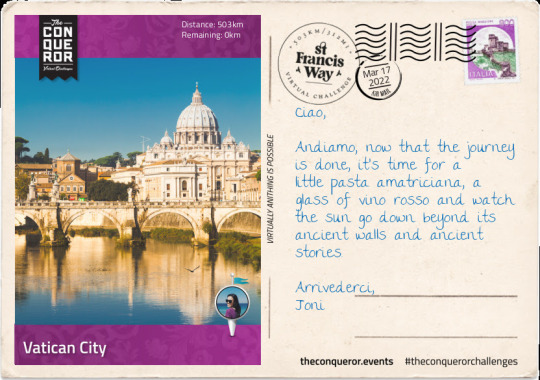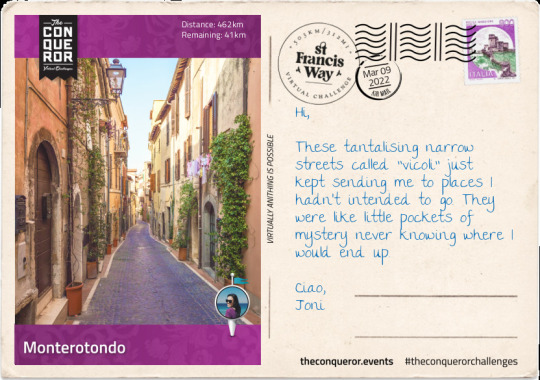#tcccamminodifrancesco
Explore tagged Tumblr posts
Photo

POSTCARD 10 @ Vatican City
I knew I was on the home stretch when I entered the Marcigliana Nature Reserve, a 4,000 hectare reserve but what I'd really like to tell you about are all the treasures of this city, well at least the highlights. As I made my way down the principal street Via Nomentana, I devised a plan to capture as many of the major landmarks that Rome is known for starting with Trevi Fountain. Tucked away in a small piazza stands the grand Fountain of Trevi. Designed by Italian architect Nicola Salvi, it is the largest fountain in the city and it stands at 86ft (26m) high and 161ft (49m) wide. Work began in 1732 and took 30 years to complete. Salvi died halfway through the works. Giuseppe Pannini was then hired to finish the construction. Palazzo Poli forms the backdrop of the fountain with its double-storey height Corinthian columns. At the forefront is a large scheme of rock and water spilling into the pool. In the centre is Oceanus, the god of fresh-water, in a shell chariot flanked by two Tritons, fish-tailed sea-daemones, taming hippocamps (sea-horses). To the left of Oceanus is Abundance, goddess of prosperity, spilling water from her urn and Salubrity, the shepherdess, holding a cup from which a snake drinks. I winged my way straight to the 2,000 years old amphitheatre, the Colosseum. Built between 72-80AD, it opened with 100 games sponsored by the Emperor Titus. The theatre could hold up to 80,000 people and averaged an audience of 65,000. Used for gladiatorial contests and mock sea battles, the Colosseum has a simple design. It is oval with high outer walls and inside are sloping tiers of seats that lead to the arena in the centre at ground level. Sand was used in the arena to give gladiators good footing but also to absorb the bloodshed. The original plan was for three levels, with each level had 80 arches (total 240 arches). Titus added a fourth level to increase capacity. Corinthian columns were added inside and out, although the outside ones were for show only. Another decorative feature on the outer wall was the 160 painted statues of emperors and gods. Each statue was different and stood 15ft (4.6m) tall inside an arch on the second and third levels. In 1349 a devastating earthquake ripped through Rome knocking down the south side of the outer wall. A major renovation was undertaken between 1992-2000 and further renovations were done throughout the last decade. In another tiny piazza is the Pantheon, a former Roman temple that was built by Emperor Hadrian circa early 2ndC. It is a cylindrical building with a large portico holding up a pediment with eight Corinthian columns at the front and two sets of four behind the front line. Exceptionally preserved it has been used as a church since the 7thC. The circular interior is covered by a dome with an oculus as its apex. Circles and squares are the theme within its interior. The checkboard floor pattern contrasts with the dome's concentric rings of square sunken panels (5 rings of 28 panels). The door and the oculus are the only source of light in the interior. The light from the oculus moves around the space as the day wears on. I crossed the Tiber River via the Ponte Sant'Angelo, an ancient Roman bridge built by Emperor Hadrian in 134AD. The bridge has five arches with the parapet walls adorned with ten angel statues, each holding an instrument of the Passion. The sculptures made of marble were the vision of Gian Lorenzo Bernini an Italian sculptor. When Pope Clement IX saw the statues he thought they were too beautiful to be displayed on the bridge and requested they be replaced with copies. The originals were placed in the church of Sant'Andrea delle Fratte in Rome. The bridge leads to the magnificent Castel Sant'Angelo, a towering cylindrical castle also built by Emperor Hadrian in early 2ndC. It was initially commissioned as a mausoleum for Hadrian but it has since been used as a castle and fortress by the popes. Around 400AD the castle was turned into a military fortress which caused many decorations to be lost. By 14thC the popes started converting the fortress back to a castle connecting it to St Peter's Basilica with a covered fortified corridor. For a period the castle was also used as a prison and executions occurred in the small inner courtyard. Decommissioned in 1901, the castle is now a museum. Bearing west of the castle, I took my final steps into the courtyard of St Peter's Basilica. Located within the Vatican City the Basilica sits at the west end of St Peter's square. Covering an area of 2.3 hectares, the Basilica has a capacity to hold more than 60,000 people making it the largest church in the world. The Basilica is believed to be the burial place of Saint Peter, who was one of the twelve apostles of Jesus and the first Bishop of Rome. Although there's no conclusive evidence of this, a tomb containing bones thought to be his was discovered under the church in the mid-20thC. St Peter's is well renowned for its Renaissance architecture largely due to the vision and design of four principal architects: Michelangelo, Bernini, Bramante and Maderno. Construction began in 1506 and took 120 years to complete. An earlier Basilica stood on this site built around the 4thC by Emperor Constantine. The central dome towers at 48ft (137m) making the church the second tallest building in Rome. An internal circular staircase of 491 steps leads up to the top of the dome with expansive views of Rome. In the piazza the Basilica is enclosed by 284 colonnades four rows deep each 39ft (12m) high, creating an elliptical shape that at its widest point measures 1,049ft long and 787ft wide (L320m x W240m). Above the colonnades are 140 statues, 15ft (4.5m) high of saints and martyrs of the church. In the centre of the piazza is an ancient Egyptian obelisk and on either side of it are two white disks. Standing on one of the disks gives the viewer the impression of only a single row of columns instead of four. Of the 266 deceased popes around 100 of them are buried beneath the Basilica. The Basilica is not a cathedral as it is often believed because it doesn't have a bishop. The pope who is the Bishop of Rome has his bishop's throne at the cathedral of Saint John Lateran. However, he uses St Peter's regularly as his main church because he lives in the Vatican. The Basilica holds many treasures such as Michelangelo's "Pieta", a sculpture depicting Jesus on the lap of Mary after the crucifixion. It is the only piece he ever signed. The bronze statue of Saint Peter Enthroned has his right foot largely worn due to pilgrims touching and kissing it for centuries. His left foot is still showing his toes as individual digits. Pope John Paull II was the most popular pontiff and he reigned for 27 years. Upon his passing he was entombed within the Basilica. Nine years after his death he was canonised and declared Saint John Paul II. St Peter's Basilica is a Catholic worshipper's final pilgrimage destination. St Francis' spiritual journey began on his pilgrimage to Rome and just as he went in search for meaning and truth so did all the pilgrims before and after him.
0 notes
Photo


DAY 97 @ Colosseum — 21,600 steps of outdoor and indoor walking at Expo 2020
0 notes
Photo


DAY 96 @ Marcello Theater — 6,438 steps of outdoor walking to Al Furjan Pavilion
0 notes
Photo










DAY 95 @ 2036 Via Venti Settembre, Rome, Lazio — 1,491 steps of outdoor walking at Business Bay
0 notes
Photo










DAY 94 @ 211 Via Nomentana, Rome, Lazio — 2,358 steps
0 notes
Photo




DAY 93 @ 387 Via Nomentana, Rome, Lazio — 15,507 steps of outdoor and indoor walking at Expo 2020
0 notes
Photo


DAY 92 @ Via della Marcigliana, Lazio — 7,696 steps of outdoor walking
0 notes
Photo

DAY 91 @ 1852 Raccordo Salario Settebagni, Lazio — 3,727 steps of outdoor walking
0 notes
Photo

DAY 90 @ 78 Via di Valle Ricca, Lazio — 7,066 steps of outdoor walking at Expo 2020
0 notes
Photo

POSTCARD 09 @ Monterotondo
Heading south into a narrow valley I passed Fonte Cottorella, known for its ancient springs of curative waters then; Monteleone Sabino with the ruins of an ancient Sabine town; Montelibretti and its 17thC palace of the noble Barberini family; and Grotta Marozza that has a 10thC ruined fortification and finally arriving in Monterotondo.
Monterotondo is a town on the outskirts of Rome. Historically it was strategic point for the defence of Rome. In the 12thC the town was sold by the noble Capocci family to the Orsini family. A noble family, the Orsinis were highly influential during medieval Italy. Across centuries several members of the Orsini family rose to prominent political and religious positions including 3 popes, 34 cardinals and many military captains.
In 1432 the town was seized from the Orsini's by Niccolo Fortebraccio, a condottiero, a captain in command of mercenary companies during the Middle Ages and multinational armies during the early modern period. The Orsini's set fire to the town 50 years later. In 1634 the town was acquired and restored by the Barberini family.
The Orsini-Barberini Castle that stands today is a 17thC palace built on top of a pre-existing castle originally owned by Orsini. The upper floors of the palace has four rooms with richly detailed frescoes from the 16thC. The rooms were originally built to host Pope Leo X and later became the private apartments of Pope Urban VIII. One of the rooms painted between 1535-1555 illustrates the life of Adonis. The smaller room has a series of frescoes that run in a continuous frieze. Called "Room of the Hunt" the artwork depicts views of Monterotondo and hunting scenes in the hills of Sabina. The third room has a coffered ceiling (a section of the normal ceiling that is recessed or raised by a series of grids) with landscape frescoes. The final room leads to a gallery with vaulted ceiling with frescoes representing Time, Hours and Fame, and reflect the use of Monterotondo Palace as a residence for the pursuit of pleasure.
In 1943 Italy unconditionally surrendered to the Allies. Germany wanting to secure Rome for themselves forced the Italian Army to setup in Orsini Castle. Hearing that the Italians were not going to surrender, the Germans decided to airdrop a battalion of 800 paratroopers with the aim to capture General Mario Roatta. Jumping over the landing zone a battle ensued until the Germans found themselves under heavy crossfire with the Italian military to their left and a group of armed civilians to their right. The fighting continued and the Germans kept advancing towards the castle. The battle ended when the Italians surrendered. Ironically General Roatta and other high ranking officials had already left the castle several days before the battle.
0 notes
Photo

DAY 89 @ Lazio — 8,825 steps of outdoor walking (Bluewaters Island)
0 notes
Photo

DAY 88 @ Archaeological Museum Lucus Feroniae — 5,882 steps of outdoor walking (Love Lake)
0 notes
Photo

DAY 87 @ Via Vecchia Nomentana, Lazio — 12,065 steps of outdoor walking (Expo 2020)
0 notes
Photo

DAY 86 @ SP28a, Lazio — 5,165 steps of indoor walking (DECC, Festival Plaza Mall)
0 notes
Photo

DAY 85 @ Str. Scandriglia Ponte, Lazio — 7,279 steps of indoor walking (Ibn Battuta Mall)
0 notes
